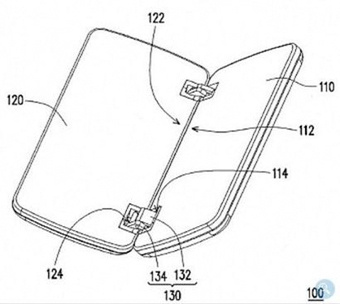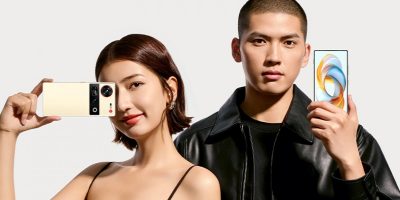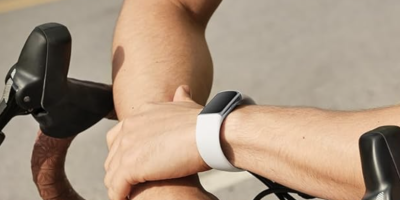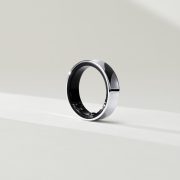Looks like HTC has just filed a patent for a device that would feature dual touchscreens in a clamshell design. Many are comparing the device to the Microsoft Courier, a similarly dual-screened device, but the Courier would be lacking one key element that is sure to make its way on to this interesting HTC design: Android.

As you can see in the above image from the patent report, the device would open up across a central hinge to reveal two screens. Word is that one will hold the content while the other will make up a virtual keyboard, at least in some instances. There is no doubt that the device could be oriented as a book reader, with a page on each screen. If this isn’t in the plans, well, HTC is missing out on a golden opportunity. An eBook reader application on a device that actually opens up and looks like a book is something I would definitely be interested in. HTC could pull off something similar to the enTourage eDGe Dualbook and no doubt improve on the concept vastly.
While there is no confirmation on whether or not the device will run Android as of yet, given HTC’s loyalty to the OS and their pioneer-spirit for Google’s open-source system if they get the little green guy on this thing and we have a real winner.
[via Tech Radar]
—-
Follow Kevin on Twitter or send him an e-mail at Kevin(at)ydfgg.com









gross. I’ll wait for a standard HTC tablet.
I wouldn’t assume that it is destined for Android. If Courier is real, Microsoft needs a hardware partner to make it. Even with HTC’s major play in Android, they are still the prominent device manufacturer for Microsoft’s mobile OS. Another MS manuf option might be Danger, but a Courier by HTC seems much more likely than one by the Sidekick folks.
Google hasn’t confirmed just how much support they’ll be giving Android tablets (specifically high-res app support in the market) let alone how they would design things for dual screens. Sure, manufacturers can tweak Android as they desire, but there is value in Google’s stamp. Fragmentation sucks enough right now and devices without native apps in the Android Market will struggle.
To counter my own comments, I will say that if Microsoft wanted such a design for Courier, they would be the ones filing the patent and then seeking a manuf to make it happen. Perhaps Google and HTC are quietly working together to leapfrog Apple and get ahead of Microsoft with a “real” dual-screen device running Android or even Chrome OS.
Intriguing design whatever it runs.
I like the idea of dual screens, especially if one can be used a full-screen keyboard when needed.
Are you nuts? think of the battery life. Yes it would be cool but it would have to be plugged in for some serious use.
What I’d really like to see is a folding screen that has no seam.
@droidking
Not if they’re OLED screens.
This is funny it reminds me of the Nokia N9000 communicator Val Kilmer used in the saint. It also brings back memories of the 6200 I used to have when I was with AT&T when 3G was first being rolled out… I left them within the 30 day trial because the reception sucked just as bad then.
@droidking
Mirasol, Pixel Qi, and OLED are all pretty low power. With a Snapdragon processor, one could easily see 10+ hours of battery life, assuming the screens are ~7″.
You never know what Froyo might do for this form factor.
I wonder how this future device will compare with next Nintendo DS 3D.
Not feeling the love on the folding thing…
The one cool thing you could do with a DS book reader would be to have the option of viewing your personal notes or footnotes on the opposing screen. As a computer tablet though, it just doesn’t make sense because the form factor is the same as a regular laptop. If I’m going to have a folding compter, may as well have the extra side be a real keyboard.
A better design would be to make the single screen tablet a larger square so that when you turn on the virtual keyboard, your viewing area is still a respectable 16×9 rectangle.
Why are people so hung up on the folding thing? That is probably one of the best features of it. When you’re not using it the screens are totally protected. I can’t want to see pictures of iPads with cracked screens.
I reckon this design will win out over the tablet because it has more functionality: a tablet, a notepad and the completely unique functionality of dual screens rolled into one.
It’s better ergonomically too. You can use it: snapped out as a tablet, held in book form, or stood open on a desk to make a photo frame, clock or music player.
So if Google wants to beat the iPad, instead of investing in a NexusPad (or whatever) they should throw everything into getting the NexusBook out.
The downside of waiting to develop a functioning dual screen device over getting out a NexusPad in the next few months (or weeks even) is that the iPad becomes firmly established as the market leader. But I don’t think a NexusPad has any serious prospect of getting much of the iPad’s market share in the next year. In the meantime there’s the WePad and others to keep the Android in the game.
And is it really in Google’s interest to be continually seen as following in Apple’s wake?
I think it would be much better to put the Google name all over a device that is clearly distinct from the iPad.
The gamble is that this design is so much better than the tablet that it will be a game changer with the NexusBook (or whatever) outselling the iPad, how much better would that be than accepting that Android is number 2.
I think these devices are going to open up a new market.
Microsoft have published papers on the type of uses you can get from a dual screen device like this, and have been playing with the courier design.
The latest news on the courier is that Microsoft is concerned about the power consumption of the dual screen device, so this is obviously the key problem, however batteries have had a recent breakthrough in a small change in the manufacturing process improves the amount of charge stored by a great deal and improves the charging speed quickly.
Obviously this isn’t ready for release today, BUT you never know if these things will be worked on more viciously over the next year with devices that will make use of it.
In terms of form factor, these forms are a digital journal, it’ll be aimed at replacing your paper notepad, BUT the tablet (ipad) will still have it’s place as a media orientated device, I think it just seems a little more natural for this use.
Will it be correlactive?